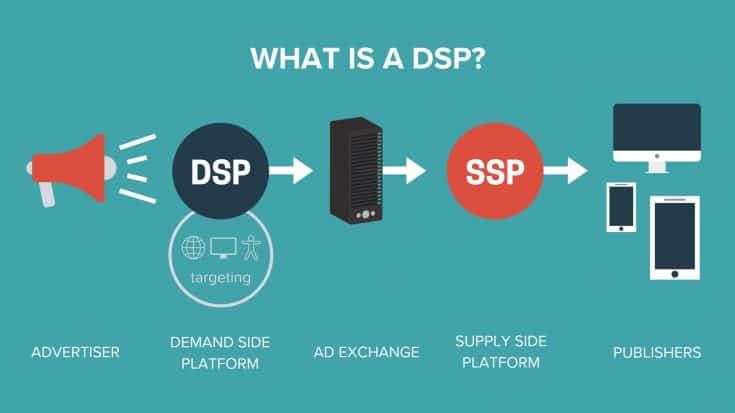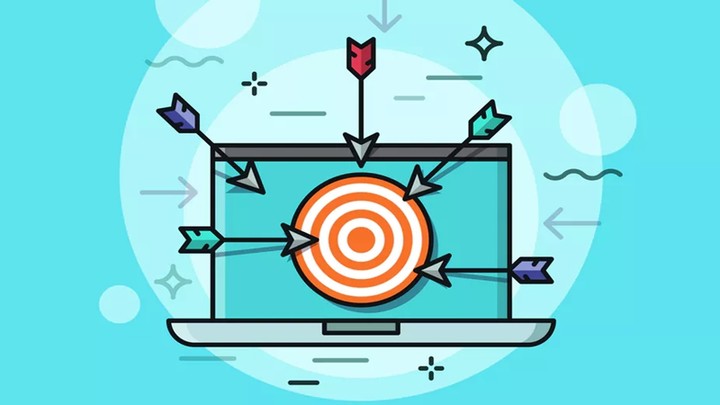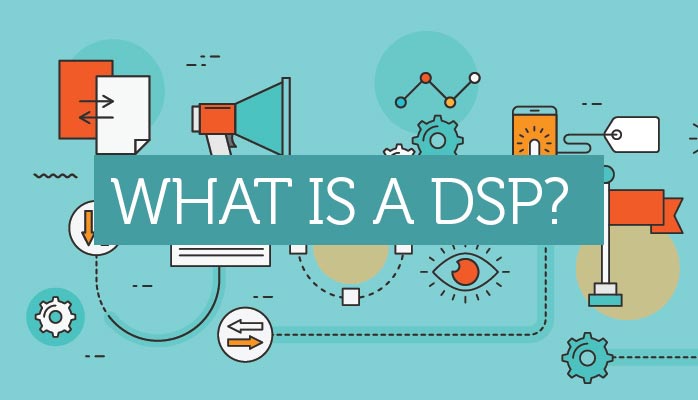Table of Contents:
A DSP gives you access to more buying sources, as opposed to only those reachable through a single third-party ad network (which is what most advertisers use). That enables you to buy audience, not just impressions.
And it means you can execute a comprehensive marketing strategy for your campaign.
But what are DSPs good for?
How does a demand-side platform fit into the ad tech stack?
In this post, I give a high-level overview of how DSPs work and what they do.
What is a DSP?
DSP stands for “demand-side platform.” A DSP is a software that lets you browse and buy programmatic ads from multiple publishers/suppliers at once (programmatic ads are ads that you can buy and manage with software).
You can make your purchases using open real-time bidding (RTB) auctions, private RTB auctions, preferred deals, or programmatic guaranteed deals.
Video, mobile, in-app, search ads, and more are available for purchase via DSPs.
How does a DSP work?

Before the introduction of DSPs, if you wanted to buy display advertising online, the whole process took much longer and involved much more human interaction. DSPs speed ad-buying up by removing elements like negotiation and, as a result, save advertisers time and money. You can also have just one person manage many ad campaigns simultaneously.
A DSP is designed to bring all the different parts of running a display ad campaign to the same place. That means you use the DSP to reach ad suppliers directly, create ad campaigns, set ad formats and targeting preferences, and optimize your campaigns. Many DSPs provide built-in algorithms that you can use to optimize your ads, and some DSPs provide the option to create your own bidding algorithm.
Using DSPs, you can monitor performance with great detail. If you’re running mobile ads, for example, you can track device type, operating system, screen size, location, etc. And if you’re buying video ads, you have access to different inventory sources, with dedicated features to accommodate the differences that exist between the various publishers (like pre-roll, mid-roll, and post-roll ads).
What is RTB?
An RTB auction is when all participating advertisers compete for the same ad placement at once. The DSP provides the winning bidder with an ad customized to meet the advertiser’s specific targeting goals. RTB auctions (AKA RTB marketplaces) can either be open or private. Private RTB auctions are sometimes called private marketplaces (PMPs), PMP programmatic, or invitation-only auctions.
RTB exists in juxtaposition to preferred deals and guaranteed buys. A preferred deal (or unreserved fixed-rate or programmatic non-guaranteed) is when a publisher sells premium ad space at a previously agreed to, fixed eCPM price. A programmatic guaranteed buy (or guaranteed buy, programmatic direct, or automated guaranteed) is when a publisher sells reserved ad space to a marketer at a fixed price. RTB is what replaced human negotiations.
What is an SSP?
SSP stands for supply-side platform. It’s the software that publishers use to make ad space available for marketers.
Through an SSP platform, publishers can set minimum prices, control who buys their inventory, and gain insights into their ad performance, all while ensuring efficient and automated sales processes for their ad spaces.
How is a DSP different from an ad exchange?
An ad exchange is an open marketplace where both publishers and advertisers come together to buy and sell ad space using DSPs and SSPs. Google Ad Manager, Microsoft Advertising, and Verizon Media are examples of ad exchanges.
DSPs aren’t really different from ad exchanges since they’re two different types of things. An ad exchange is where you use your DSP.
How is a DSP different from an ad network?

Ad networks often buy unsold ad space from different publishers and resell that ad space for less than what the publisher would sell it for directly. This kind of ad inventory may be called non-premium or remnant. Ad networks can also offer exclusive access to premium ad space that’s resold at premium prices. This may be a pricier route to go, but it guarantees advertisers get premium ad space. Examples of ad networks include Google Display Network and Conversant.
Ad networks share some commonalities with DSPs in so far as both provide an opportunity to buy ad space. The advantage of a DSP is that in addition to buying ads, which is the only thing you can do with an ad network, you can also manage, track, and optimize your campaigns. A DSP is a one-stop-shop. Ad networks also usually have a mark-up on the ads, but a DSP may not because it connects you straight to the publisher. Although, DSPs may have hidden fees–more on that later!
What is a self-service DSP?
A self-serve DSP is what most people think about when they’re discussing DSPs. What is meant by “self-serve” is that no third-party professionals are running your campaign for you; you’re using the DSP yourself. You feed the DSP money, upload your ad creative, tweak your settings, and then launch your campaign.
How do I choose a DSP?
There are several considerations to make when choosing your DSP.
- The number of ad suppliers.
- The types of ads it accommodates, such as in-app advertising, mobile, video, etc.
- Available third-party data integrations.
- Available targeting options.
- Their monthly minimum spend or platform access fee
Do DSPs have hidden fees?
There are three well-known ways that DSPs may charge hidden fees.
- Using a higher winning bid than an open exchange: The clearing price is the bid that wins during RTB. Sometimes, though, the bid that wins within the DSP will be less than the price that won on the open exchange, and the DSP will pocket the difference. This happens if the open exchanges use second-price auctions, which means that the winning bid is determined by the second-highest bid. Luckily, you can find many ad exchanges that use first-price auctions, like Google Ad Manager.
- Marking Up Add-Ons: A DSP may offer, for example, targeted advertising for a fee using a particular service, but there may be a discrepancy between how much the service charges and how much the DSP charges. The service may cost $1 per thousand impressions, but the DSP may charge you $1.50 per thousand impressions and, again, pocket the difference. That adds up to a lot over time!
- Marking Up Special Inventory: It makes sense that a fee would be charged for access to premium ad space that results from deals between an SSP and a DSP. It becomes an issue, however, when DSPs don’t tell users how much more they’re charging than the price they negotiated with the SSP.
So, read the fine print when you select your DSPs and read reviews as well. Privately owned DSPs are not required to disclose their financial statements in the way that publicly owned ones are, making it harder to identify significant mark-ups.
At Moving Traffic Media, our preference is to use self-service DSPs when managing display and video campaigns for our clients. The self-service tools give us the most control and assure we never have to rely on someone outside our agency when things need to get done.







